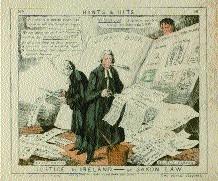‘hints and hits’: Irish caricature and the trial of Daniel O’Connell, 1843–4
Published in 18th–19th - Century History, Features, Issue 4 (Winter 2004), Volume 12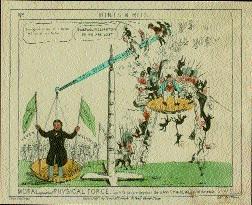 On 7 October 1843 the lord lieutenant of Ireland issued a proclamation banning the ‘monster meeting’ scheduled for the following day at Clontarf, in the northern suburbs of Dublin. Some 2,500 troops, nearly 1,000 constabulary and four field guns were deployed to enforce the order. With only hours to spare, the organisers of the demonstration, the Loyal National Repeal Association, issued cancellation notices and sent out agents to turn back the columns of marchers—anticipated to number over half a million—from Dublin and the surrounding counties. The rapidity and efficiency of the Repeal reaction ensured that there was no confrontation at Clontarf and that the day passed off peacefully.
On 7 October 1843 the lord lieutenant of Ireland issued a proclamation banning the ‘monster meeting’ scheduled for the following day at Clontarf, in the northern suburbs of Dublin. Some 2,500 troops, nearly 1,000 constabulary and four field guns were deployed to enforce the order. With only hours to spare, the organisers of the demonstration, the Loyal National Repeal Association, issued cancellation notices and sent out agents to turn back the columns of marchers—anticipated to number over half a million—from Dublin and the surrounding counties. The rapidity and efficiency of the Repeal reaction ensured that there was no confrontation at Clontarf and that the day passed off peacefully.
Clontarf a turning-point
The Clontarf proclamation and the ensuing state trials were a turning-point in the history of the nationalist movement. Daniel O’Connell had proclaimed 1843 to be the ‘Repeal Year’ and initiated a sustained campaign of ‘monster meetings’ throughout the three southern provinces of Ireland to mobilise mass support for the repeal of the legislative union between Ireland and Great Britain. The campaign posed a serious problem for the British Conservative government headed by Prime Minister Sir Robert Peel and led in the House of Lords by the duke of Wellington. Under pressure from his supporters to repress the subversive movement, Peel was hesitant to act until he felt sure he had sufficient legal grounds to proceed. An unauthorised Repeal notice announcing a ‘parade’ of a ‘Repeal cavalry’ at Clontarf was seized upon as grounds for a proclamation, but this was only the beginning: government law officers were set to work to draw up indictments against O’Connell and his principal lieutenants based on the speeches made and newspaper articles published in the preceding months. On 14 October 1843 warrants were issued against O’Connell and eight other ‘traversers’ on charges of conspiring to undermine the constitution and alienating the armed forces from their allegiance.
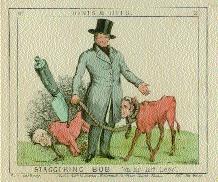 O’Connell’s decision to cancel the Clontarf meeting and to submit to the indictments was regarded as a betrayal of the nationalist cause by the more militant Young Irelanders. But O’Connell had grasped that the Peel administration could not be browbeaten into conceding Repeal in the way that the Wellington government had granted Catholic Emancipation in 1829, and many contemporaries suspected that he was secretly relieved at the state’s suppression of a mass agitation that had served its purpose but which could not be maintained without degenerating into apathy or frustrated violence.
O’Connell’s decision to cancel the Clontarf meeting and to submit to the indictments was regarded as a betrayal of the nationalist cause by the more militant Young Irelanders. But O’Connell had grasped that the Peel administration could not be browbeaten into conceding Repeal in the way that the Wellington government had granted Catholic Emancipation in 1829, and many contemporaries suspected that he was secretly relieved at the state’s suppression of a mass agitation that had served its purpose but which could not be maintained without degenerating into apathy or frustrated violence.
Yet if the Repeal campaign was not to collapse completely under the weight of government prosecutions, it needed to adapt to changed circumstances. For O’Connell himself, perhaps the most successful Irish barrister of his generation, the courtroom was a familiar stage on which to perform. The long-drawn-out drama of the state trial process, from the grand jury’s finding of the indictment in November 1843, through the jury selection and trial proceedings of January and February 1844, to the sentence of a year’s imprisonment on 30 May and the quashing of the convictions on appeal in September, attracted intense public interest. The court galleries and approaches to the Four Courts in Dublin were frequently thronged; detailed accounts appeared in the press and were serialised as pamphlets.
Close interest in the trial was widespread throughout Ireland and beyond, and the debates on O’Connell’s guilt or innocence in 1844 were rehearsed in many spheres outside the formal confines of the Court of Queen’s Bench. The matter was debated intensely in parliament, at public meetings in Ireland and Britain, in the press, through songs and ballads, and through caricature.
Most caricature hostile to Irish nationalism
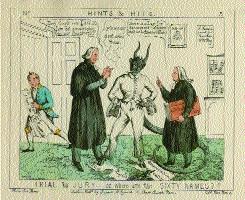 The place of caricature in political controversy has long attracted the attention of historians, but Roy Douglas, Liam Harte and Jim O’Hara’s Drawing conclusions: a cartoon history of Anglo-Irish relations 1798–1998 was the first attempt to create a comprehensive survey of Irish-related political caricature. Useful as it is, their selection suggests a remarkable absence of Irish-produced caricature before the introduction of political cartoons in A.M. Sullivan’s Weekly News in the 1860s. With the exception of a smattering of anti-Union cartoons around 1800 and Henry Brocas’s savage depictions of 1798 atrocities in Cox’s Irish Magazine (1807–15), all the material reproduced for this period originated in Britain, and was predominantly (although not exclusively) hostile to Irish nationalism. Yet at least one series of political caricatures enthusiastically supportive of nationalism was created and distributed in Ireland within this period—a series entitled ‘Hints and Hits’, published in Dublin in early 1844.
The place of caricature in political controversy has long attracted the attention of historians, but Roy Douglas, Liam Harte and Jim O’Hara’s Drawing conclusions: a cartoon history of Anglo-Irish relations 1798–1998 was the first attempt to create a comprehensive survey of Irish-related political caricature. Useful as it is, their selection suggests a remarkable absence of Irish-produced caricature before the introduction of political cartoons in A.M. Sullivan’s Weekly News in the 1860s. With the exception of a smattering of anti-Union cartoons around 1800 and Henry Brocas’s savage depictions of 1798 atrocities in Cox’s Irish Magazine (1807–15), all the material reproduced for this period originated in Britain, and was predominantly (although not exclusively) hostile to Irish nationalism. Yet at least one series of political caricatures enthusiastically supportive of nationalism was created and distributed in Ireland within this period—a series entitled ‘Hints and Hits’, published in Dublin in early 1844.
This series represents a riposte to the dominant Unionist rhetoric of London-produced caricature. In the early 1840s this was still dominated by the conservative Irish Catholic John Doyle, whose voluminous output of ‘Political Sketches’ and ‘Political Hits’ were signed with the pseudonym ‘HB’. From 1841 Doyle’s reign was increasingly challenged by a new medium—the weekly comic magazine. The most successful of these, Punch, rapidly acquired a core market that was larger and more middle-class than HB’s, and its product was somewhat coarser in style and content.
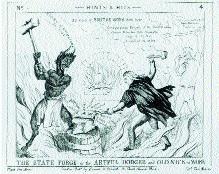 Both Doyle’s and Punch’s images of Repeal and the O’Connell trial would have been available in Dublin (and viewable in print-shop windows for those who could not afford their own copies), and may well have provoked the ‘Hints and Hits’ counterblast. Given the intensity of feeling surrounding the Repeal campaign and the state prosecutions, and the animosity manifest in British caricature representations of the crisis, it is perhaps not surprising that they should have called forth an Irish nationalist response.
Both Doyle’s and Punch’s images of Repeal and the O’Connell trial would have been available in Dublin (and viewable in print-shop windows for those who could not afford their own copies), and may well have provoked the ‘Hints and Hits’ counterblast. Given the intensity of feeling surrounding the Repeal campaign and the state prosecutions, and the animosity manifest in British caricature representations of the crisis, it is perhaps not surprising that they should have called forth an Irish nationalist response.
Although Ireland appears not to have supported a commercial caricature market before 1844, it had no shortage of graphic artists and illustrators. Locally produced periodical publications like the Dublin Penny Journal had carried engraved illustrations, and bookplates were not uncommon.
However, there seems to have been no direct forerunner to the ‘Hints and Hits’ series. These were introduced to the buying public in an advertisement placed in the Nation on 27 January 1844. Published by James McCormick of Christchurch Place, Dublin, who also offered serialised accounts of the state trials alongside other nationalist pamphlets, they were offered for sale at the relatively low price of a penny each (tuppence for the hand-coloured version). The prints were signed ‘Wm Tell’—probably a pseudonym inspired by the Swiss patriot recently celebrated in Rossini’s popular opera. The first two prints appeared on 27 January, with a further ‘number’ (a pair of prints) following weekly. It appears that twelve were published in total: a complete coloured set is held in the Bodleian Library in Oxford, and a nearly complete mixed set in the British Museum in London.
‘Moral against Physical Force’
The first print, ‘Moral against Physical Force’ (Fig. 1), is reminiscent of the British radical prints dating from the Reform Act crisis of the early 1830s. The idea is simple, although the effect is cluttered by a multiplication of figures on both sides and an excess of text. In the scales of justice—an explicit reference to the state trials which had now reached their twelfth day—O’Connell and truth, supported by the ‘7 millions’ of Irish Catholics, easily outweigh the ‘Physical Force’ of John Bull and his myriad associates of soldiers, judges, (Anglican) bishops and quarrelsome devils (at least fifteen of whom swarm about). Two Shakespearian tags add gravitas to the Irish case: the subtitle ‘on his choice depends the sanity and health of the whole state’ is a rather unfortunate equation of O’Connell and Hamlet; ‘Foul deeds will rise’ is a rather less complicated tag. The British side is personalised with representations of Peel and Wellington—a running theme of ‘Hints and Hits’—with the duke’s name punned as ‘Villainton’.
In contrast to No. 1, its companion piece, No. 2 (Fig. 2), is stark and simple, with text relegated from the pictorial field to the caption below. ‘Staggering Bob on his last legs’ embodies the original rationale of the 1843 ‘Repeal Year’ campaign, reiterated in January 1844 when such hopes were fading, presumably to raise faltering morale and reinforce faith in O’Connell’s political judgement. The metaphor used here is that of the butchery trade, where a ‘staggering Bob’ is a veal calf ready for slaughter. One calf, bearing Wellington’s features, lies slaughtered by the outsized knife of ‘Emancipation’; the second (‘Bob’ is, of course, a contraction for Robert), Peel, is haltered with ‘Repeal’ and wholly under O’Connell’s control.
Row over jury selection
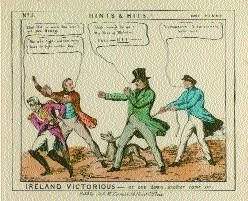 A week later a linked pair appeared commenting explicitly on the trial proceedings. The devil dominates in both, as the mentor and guide of the state prosecutors—advising them not to mind any criticisms of their proceedings. In No. 3 (Fig. 3) the narrative relates to the selection of the jury to try O’Connell and the traversers, the arrangement of which became a key grievance for the defence. The special jury for the state trials was to be selected from the revised County Dublin jury panel, itself severely restricted by a high property qualification. Of the 48 names drawn from the panel by ballot, prosecution and defence were entitled to exclude twelve names each—and the twelve removed by the state included all the remaining Catholics. This proceeding explains the lawyer on the right (the Irish attorney general, Thomas Berry Cusack Smith) announcing his apparent discovery of a law that Catholics shall not be tried by Catholics. This exclusion offended even moderate Catholic opinion in Ireland and allowed the prosecution to be branded as sectarian. It was subsequently revealed that about 60 juror names had been left out of the revised panel. The responsible officer, the recorder of Dublin and Conservative MP Frederick Shaw (hence the devil’s ‘P’Shaw’), claimed that this was the accidental consequence of clerical error (his butler, apparently, had failed to send the missing sheets to him while he was staying with Peel at Tamworth). Repealers, claiming that more than half of the ‘60 names’ were Catholics or Liberal Protestants, were convinced that this was part of an official conspiracy to ‘pack’ the trial jury.
A week later a linked pair appeared commenting explicitly on the trial proceedings. The devil dominates in both, as the mentor and guide of the state prosecutors—advising them not to mind any criticisms of their proceedings. In No. 3 (Fig. 3) the narrative relates to the selection of the jury to try O’Connell and the traversers, the arrangement of which became a key grievance for the defence. The special jury for the state trials was to be selected from the revised County Dublin jury panel, itself severely restricted by a high property qualification. Of the 48 names drawn from the panel by ballot, prosecution and defence were entitled to exclude twelve names each—and the twelve removed by the state included all the remaining Catholics. This proceeding explains the lawyer on the right (the Irish attorney general, Thomas Berry Cusack Smith) announcing his apparent discovery of a law that Catholics shall not be tried by Catholics. This exclusion offended even moderate Catholic opinion in Ireland and allowed the prosecution to be branded as sectarian. It was subsequently revealed that about 60 juror names had been left out of the revised panel. The responsible officer, the recorder of Dublin and Conservative MP Frederick Shaw (hence the devil’s ‘P’Shaw’), claimed that this was the accidental consequence of clerical error (his butler, apparently, had failed to send the missing sheets to him while he was staying with Peel at Tamworth). Repealers, claiming that more than half of the ‘60 names’ were Catholics or Liberal Protestants, were convinced that this was part of an official conspiracy to ‘pack’ the trial jury.
In No. 4 (Fig. 4) the devil, now stripped to essentials, labours in the state forge (a double entendre) hammering out the law to convict the traversers. Smith’s work (that is, the attorney general’s) is done in this infernal smithy. Meanwhile Wellington, working the bellows, complains that the place is hotter than Waterloo.
“Ireland Victorious’
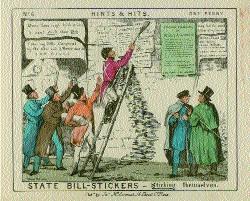 Numbers 5 and 6 also form a pictorially related pair. ‘Ireland Victorious’ (Fig. 5) juxtaposes two pairs of figures. On the right is a pugilistically posed O’Connell and, struggling to hold back the emblematic Irish wolfhound, Thomas Steele, the ‘head pacificator’ of the Repeal movement, a Protestant landowner and O’Connell’s most personally devoted adherent. On the left Wellington, already winded by the blow of ‘Emancipation’, staggers away from Ireland’s paramount prize-fighter; Peel, fearing the outstretched arm of Repeal, also flees. This is also a simple morale-booster, reassuring the faithful that, despite appearances, the Repeal cause was still alive and would ultimately triumph.
Numbers 5 and 6 also form a pictorially related pair. ‘Ireland Victorious’ (Fig. 5) juxtaposes two pairs of figures. On the right is a pugilistically posed O’Connell and, struggling to hold back the emblematic Irish wolfhound, Thomas Steele, the ‘head pacificator’ of the Repeal movement, a Protestant landowner and O’Connell’s most personally devoted adherent. On the left Wellington, already winded by the blow of ‘Emancipation’, staggers away from Ireland’s paramount prize-fighter; Peel, fearing the outstretched arm of Repeal, also flees. This is also a simple morale-booster, reassuring the faithful that, despite appearances, the Repeal cause was still alive and would ultimately triumph.
In ‘State Bill-Stickers—Sticking Themselves’ (Fig. 6), Peel and Wellington are reinforced by two ‘Peelers’—policemen dressed in the garb of Peel’s London Metropolitan Police rather than the Whig-created Irish Constabulary. Wellington, using a reversed musket, attempts in vain to make the Clontarf proclamation stick. The proclamation is signed ‘De Bray’—a pun on the name of the viceroy, Lord De Grey. More dreadful puns follow—Peel advises Wellington that if paste won’t do, ‘try Steel’, a reference to the inclusion of Tom Steele in the list of traversers. On the right, O’Connell (in reversal of the violent stance of No. 5) now restrains Steele’s (and implicitly Young Ireland’s) impulse towards unconsidered action—moral force and the exposure of dark deeds will alone win the day.
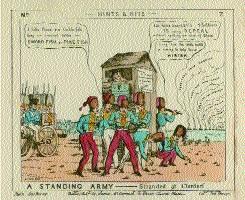 The Clontarf proclamation also forms the subject of No. 7 (Fig. 7). Here the ‘standing army’ uselessly occupies the deserted strand at Clontarf, and is urged by O’Connell to go home quietly. Humiliating submission to state diktat is here turned into triumph—bloodshed is avoided by O’Connell’s wisdom. The Cockney soldiers are amiably mocked (it is not they but their masters who want conflict), while one spies on the horizon a fleet of Repeal supporters arriving from abroad. The importance of such diasporic connections had long been part of O’Connell’s repertoire, but the image of ships from America and France may also have carried another nationalist message in this context—the limited support Ireland was likely to offer Britain in the case of international war, so long as Repeal was denied.
The Clontarf proclamation also forms the subject of No. 7 (Fig. 7). Here the ‘standing army’ uselessly occupies the deserted strand at Clontarf, and is urged by O’Connell to go home quietly. Humiliating submission to state diktat is here turned into triumph—bloodshed is avoided by O’Connell’s wisdom. The Cockney soldiers are amiably mocked (it is not they but their masters who want conflict), while one spies on the horizon a fleet of Repeal supporters arriving from abroad. The importance of such diasporic connections had long been part of O’Connell’s repertoire, but the image of ships from America and France may also have carried another nationalist message in this context—the limited support Ireland was likely to offer Britain in the case of international war, so long as Repeal was denied.
‘The Irish Lion’ (Fig. 8) is reminiscent of Doyle’s many sketches employing this motif, although here the leonine O’Connell is depicted without irony or malice. O’Connell’s ‘tail’ is no longer the denigrated ‘Irish party’ at Westminster but the ‘great number’ of seven million Irish Catholics. Ireland before the Famine, it is worth recalling, accounted for about one third of the United Kingdom’s population, and the Repeal campaign was explicitly democratic in its orientation, if not in its organisation or its focus on the charismatic authority of the leader. The lion’s baiters either lie prostrate (Wellington and Peel) or flee in terror (Home Secretary James Graham, Lord Chancellor Lyndhurst and Irish Attorney General Smith). The image lacks HB’s skill of composition and drafting, but would have been none the less powerful to its penny-a-print purchasers and print-shop viewers for that.
‘More Power to Paddy’
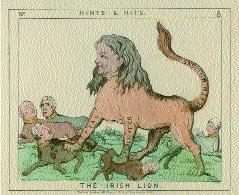 The remaining ‘Hints and Hits’ date from after the jury’s conviction of O’Connell and the other traversers on 12 February 1844. This might have been a serious blow, but many of O’Connell’s (and indeed the government’s) supporters remained sceptical that the state would see off the multiple procedural objections provoked by this unquestionably political trial and enforce a verdict.
The remaining ‘Hints and Hits’ date from after the jury’s conviction of O’Connell and the other traversers on 12 February 1844. This might have been a serious blow, but many of O’Connell’s (and indeed the government’s) supporters remained sceptical that the state would see off the multiple procedural objections provoked by this unquestionably political trial and enforce a verdict.
In ‘More Power to Paddy’ (Fig. 9), perhaps the most politically sophisticated of the series, ‘Wm Tell’ puts the Irish question into a broader context. John Bull, the embodiment of England, is saddled by financial problems and surrounded by domestic and imperial threats: to the left he is assailed by English anti-Poor Law protestors, the Welsh ‘Rebecca rioters’ who had taken violent action against road tolls in 1843, and the radical Chartist movement (in keeping with O’Connellite antagonism towards the Chartists, then led by his personal rival Feargus O’Connor, this is represented here as an unambiguously physical-force movement, demanding ‘The Charter or —-’). To the right, violence is threatened by America (the armed native here represents the United States, then in a heated border dispute with the British Empire over Oregon) and by China, the victim of Britain’s first Opium War of 1839–42, now seeking vengeance ‘for poisoning my people with Opium and then plundering them’. In contrast, only O’Connell and Repeal offer the reasonable alternative of moral force, yet this appears to be the one issue on which John Bull will concede nothing. Paddy, the cartoonist assures his audience, can only benefit from this multitude of problems engulfing the British state.
No. 10 (Fig. 10) narrates an older and simpler story. Here O’Connell is the new St Patrick, ‘driving the foreign toads and vipers from the land’; as he does so he sings a new Repeal song, a reminder of the importance of political balladry to the movement and of the interconnection between different forms of Repeal propaganda. The vermin include not only the usual suspects—Wellington and Peel at bottom, other ministers, such as ‘Either-side Graham’ and ‘Scorpion Stanley’ (references to their defection from the Whigs in the ‘Derby Dilly’ of 1834–5), and a flying T.B.C. Smith clutching his ‘60 names’, trailing conspiracy and accompanied by a ‘bad judge’—but also the Times, singled out for its vituperative coverage of the state trials. Alongside these, not associated with the trials but a hate-object for many nationalists, is the Protestant Church of Ireland, rendered as a reptilian creature with a tail of ‘endless plunder’ and the face of Archbishop Richard Whately of Dublin. The motto ‘Mother Bang’ on the bishop’s mitre is obscure, but his speech is not: ‘O’Connell will be the death of us’.
The unfortunate Archbishop Whately appears again, on the left of No. 11 (Fig. 11), as the chair of the National Board of Education for Ireland. But here the ‘national education’, of rather disciplinary description, is not that of the state system but that of O’Connell the ‘Kerry schoolmaster’. Attorney General Smith is thrashed for insolence, and blames the supporting Wellington as instigator, while other ministers wait their turn. O’Connell’s textbook, on the floor to the right, is ‘Grattan, Flood and Charlemont on Irish Laws’, a reference to the eighteenth-century Protestant Patriot tradition which O’Connell appropriated to provide a non-revolutionary historical antecedent for the campaign for Irish self-government or ‘legislative independence’. Again, the cartoonist sees no contradiction between the slogan of ‘moral force’ and the allegorical depiction of disciplinary violence against deserving culprits.
‘The man who commits a crime gives strength to the enemy’
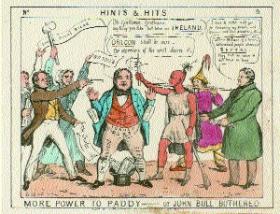 The final cartoon of the series (Fig. 12) addresses directly the legal proceedings relating to the trial. Here the state’s Irish legal officers, Attorney General Smith and Solicitor General Moore, prepare the prosecution case. To the right are ‘select scraps’ extracted out of context from monster-meeting speeches and the nationalist press (John Gray and Charles Gavan Duffy, the editors of the Freeman’s Journal and the Nation, were amongst the ‘traversers’). Membership cards of the Repeal Association and ‘Volunteers of 1782’—both of which featured in the prosecution case—are pasted into the state scrapbook. On the left, a pile of ‘scrap paper’ contains all the contrary evidence—‘Peaceable meetings’, ‘Temperance’, ‘Moral and constitutional reform’, ‘Right of free discussion’, and about to join them is the slogan frequently displayed at Repeal meetings, ‘The man who commits a crime gives strength to the enemy’. Having prepared their skewed and false case, the lawyers have now turned to doctoring the jury list, cutting out the ‘60 bad names’ and leaving ‘a list of the right sort for anti-national purposes’.
The final cartoon of the series (Fig. 12) addresses directly the legal proceedings relating to the trial. Here the state’s Irish legal officers, Attorney General Smith and Solicitor General Moore, prepare the prosecution case. To the right are ‘select scraps’ extracted out of context from monster-meeting speeches and the nationalist press (John Gray and Charles Gavan Duffy, the editors of the Freeman’s Journal and the Nation, were amongst the ‘traversers’). Membership cards of the Repeal Association and ‘Volunteers of 1782’—both of which featured in the prosecution case—are pasted into the state scrapbook. On the left, a pile of ‘scrap paper’ contains all the contrary evidence—‘Peaceable meetings’, ‘Temperance’, ‘Moral and constitutional reform’, ‘Right of free discussion’, and about to join them is the slogan frequently displayed at Repeal meetings, ‘The man who commits a crime gives strength to the enemy’. Having prepared their skewed and false case, the lawyers have now turned to doctoring the jury list, cutting out the ‘60 bad names’ and leaving ‘a list of the right sort for anti-national purposes’.
Observing the scene from outside the frame, O’Connell reassures his followers: ‘Na Bocklish’ (never mind it), he quips in Irish, ‘I’ll drive a coach and six through this judge-made law’. Further reassurance comes from the lawyers’ spoken doubts that the charge will hold and their fear that O’Connell will again slip through their fingers. O’Connell’s Irish tag is significant. Although a native Irish-speaker, he rarely used the language in public discourse (this tag is an exception and did appear in his Repeal speeches). Nevertheless, in the popular culture of O’Connellism his command of the language and ability to communicate with the common people in a tongue not understood by the authorities was a common theme. As ‘the Counsellor’, a defence lawyer believed to have almost supernatural abilities, O’Connell had been famed for his skill in undermining state prosecutions and securing unlikely acquittals. This legal reputation carried over into the Repeal era and served O’Connell well when the political focus shifted from the mass outdoor rally to the courtroom in 1844. The unlikely quashing of the conviction in September could only reinforce the myth of O’Connell’s legal invincibility.
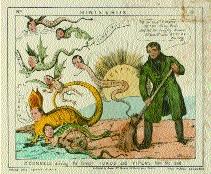 With No. 12 the ‘Hints and Hits’ series ends rather abruptly, with the last pair probably appearing on 2 March 1844. It is unclear from the evidence what impact the series had or how well they sold, or indeed why the series folded. McCormick, the publisher, was one of a number of competing nationalist printers and probably produced the set as a commercial venture rather than as the result of a commission; from the frequency of advertisements in the Repeal press, it may be that McCormick struggled against the more aggressive and successful printers such as John Duffy (both brought out rival editions of the state trial proceedings, but advertisements for McCormick’s appear to have disappeared rapidly). Printers also mass-produced and marketed cheap engraved prints of O’Connell and the other traversers, although again it appears that other printers were more successful at this.
With No. 12 the ‘Hints and Hits’ series ends rather abruptly, with the last pair probably appearing on 2 March 1844. It is unclear from the evidence what impact the series had or how well they sold, or indeed why the series folded. McCormick, the publisher, was one of a number of competing nationalist printers and probably produced the set as a commercial venture rather than as the result of a commission; from the frequency of advertisements in the Repeal press, it may be that McCormick struggled against the more aggressive and successful printers such as John Duffy (both brought out rival editions of the state trial proceedings, but advertisements for McCormick’s appear to have disappeared rapidly). Printers also mass-produced and marketed cheap engraved prints of O’Connell and the other traversers, although again it appears that other printers were more successful at this.
Market smaller and poorer than in Britain
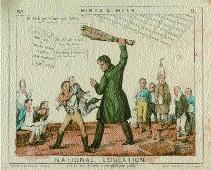 For whatever reason, the production of political caricatures in Dublin seems to have ceased with ‘Hints and Hits’. The market was always smaller and poorer than in Britain, enthusiasm for Repeal was diminishing after the excitement of 1843 and early 1844, and O’Connellite nationalism was swept away and popular purchasing power slashed by the famine that engulfed Ireland from late 1845. It was not until the later 1860s that the tradition of caricature was firmly re-established in Irish nationalist political culture.
For whatever reason, the production of political caricatures in Dublin seems to have ceased with ‘Hints and Hits’. The market was always smaller and poorer than in Britain, enthusiasm for Repeal was diminishing after the excitement of 1843 and early 1844, and O’Connellite nationalism was swept away and popular purchasing power slashed by the famine that engulfed Ireland from late 1845. It was not until the later 1860s that the tradition of caricature was firmly re-established in Irish nationalist political culture.
Despite its ephemeral nature, ‘Hints and Hits’ served well the purpose for which it was created—the maintenance of nationalist morale and of O’Connell’s authority within the movement at a time of political crisis. Other propaganda forms may have reached a wider audience, but the themes and symbols of the series were in tune with those of other media, and they give us an unusual and significant insight into the visual world of the O’Connellite movement.
Peter Gray lectures in history at Queen’s University, Belfast
Further reading:
R. Douglas, L. Harte and J. O’Hara, Drawing conclusions: a cartoon history of Anglo-Irish relations 1798–1998 (Belfast, 1998).
O. MacDonagh, The Emancipist: Daniel O’Connell 1830–47 (London, 1989).
G. Owens, ‘Nationalism without words: symbolism and ritual behaviour in the Repeal “monster meetings” of 1843–5’, in J.S. Donnelly and K. Miller (eds), Irish popular culture 1650–1850 (Dublin, 1998).
